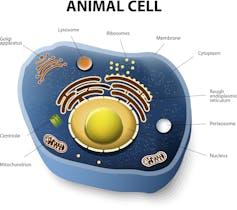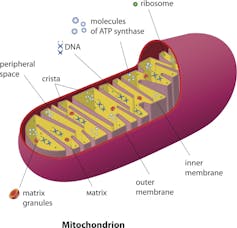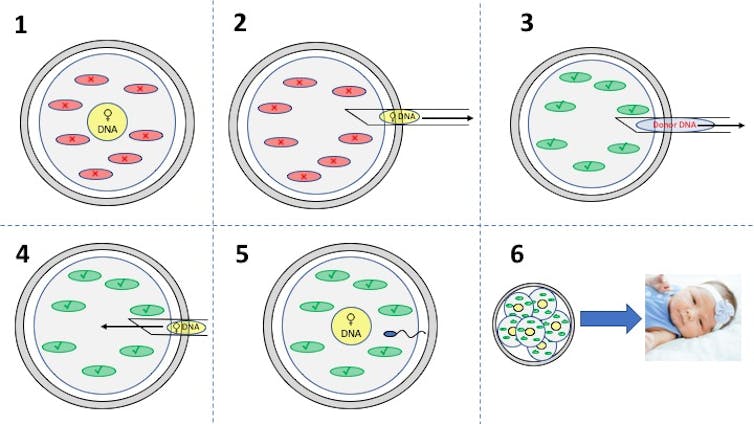Can a Baby Have Traits of Two Fathers
It seems impossible, right? We accept been taught from the time nosotros were young that babies are made when a sperm and an egg come together, and the DNA from these two cells combine to make a unique individual with half the DNA from the mother and half from the father. So how can there be a third person involved in this process?
To empathize the idea of three-parent babies, we have to talk virtually DNA. Most people are familiar with the double helix-style DNA which make up the 23 pairs of chromosomes that are found in the nucleus of every cell in our body. It provides the instructions for edifice an entire organism and the proteins that drive our existence from conception until death. Notwithstanding, the Deoxyribonucleic acid in the nucleus is not the only kind of DNA required for us to be. There is also DNA tucked away in little compartments called mitochondria, that are found inside all of the cells in your body.

Remember the mitochondria? Dig deep back to middle or high schoolhouse biology course. It was that bean-shaped organelle often drawn with a squiggly line on it and called the powerhouse of the cell. Each cell in the body, including eggs and sperm, requires energy to conduct out all of its functions. Cells without functional mitochondrial DNA (mtDNA) are like cars without gas.

Dissimilar nuclear Deoxyribonucleic acid, mtDNA is non created by the combination of male person and female DNA. Instead, mitochondria are only inherited from your mother, meaning that ones that are in the fertilized egg are the ones that volition exist replicated in every cell of your body during your development and for the balance of your life.
Simply like nuclear DNA, mtDNA tin have mutations that can lead to very serious, debilitating diseases, and in some cases, infertility for a adult female carrying the lacking mitochondria. Enter the third parent.
The tertiary parent
In 2016, a infant was born to a couple who had struggled with the consequences of mtDNA mutations that cause Leigh syndrome, a progressive neurometabolic disorder. When defective mitochondria of the woman's egg were replaced with mitochondria from a donor who did not carry the mutation, the resulting child carried Dna from three people: the female nuclear Deoxyribonucleic acid donor, the male nuclear Deoxyribonucleic acid or sperm donor, and the female mitochondria donor. This was the first baby built-in using this technique.

This technique, termed mitochondrial replacement, can exist idea of similar an organ transplant, or rather organelle transplant. However, there are some significant differences that take created concern amongst legislators, resulting in a ban on mitochondrial replacement in the U.S..
Unlike an organ transplant, the effects of mitochondrial replacement will persist in future generations of offspring if the resulting infant is a female and she chooses to have children – males do not laissez passer on their mitochondria. Also, the replacement will touch on every tissue in the body, rather than simply 1 trunk system, such as the cardiovascular system afterward a heart transplant.
Nonetheless, these donated mitochondria are naturally occurring and already persisting in our population. They are not genetically engineered or altered in whatsoever fashion. Thus, equally long as they are functioning properly, there is no demonstrated risk to the offspring from a health standpoint across the naturally occurring risks of spontaneous mutations, though this is a point of debate.
Since 2016, it'due south difficult to say how many of these three-parent procedures have been done and how many resulted in successful pregnancies. But with the contempo birth of a babe in the Ukraine that involved three parents, many countries are at present exploring if and how to use this technology. The ban in the U.Due south. has halted the use hither but other countries have made dissimilar decisions; the U.Yard. has canonical it.
Is the mitochondrial donor a parent?
And so how much a parent is a woman who donates her mitochondria?
The brusque answer is non much. More than 99 percentage of the proteins in your body are encoded past the Deoxyribonucleic acid in the nucleus of your cells. Traits such as pilus colour, centre colour and superlative, for case, are all encoded past nuclear DNA, while genes written on mtDNA are primarily related to energy production and metabolism.
Thus three-parent babies will even so resemble the men and women whose sperm and egg combined to produce the 23 chromosomes in the nucleus of that first cell. Information technology's important for people to empathise these distinctions as headlines announcing births of three-parent babies volition likely continue to surface. Speculation of what it ways could run rampant without understanding the underlying science.
1 thing is sure: For women who struggle with infertility acquired by mutations in their mitochondrial DNA, or have the potential to pass on significant mitochondrial genetic defects, this new technique provides hope that they may one 24-hour interval be able to have a healthy child that is a genetic representation of them and their partner – with a little help from a third party.
Source: https://theconversation.com/how-can-a-baby-have-3-parents-97991
0 Response to "Can a Baby Have Traits of Two Fathers"
Post a Comment